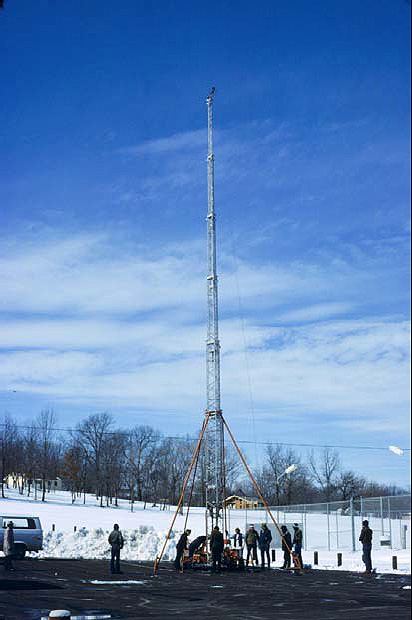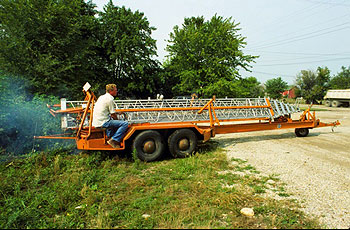Trailer Mounted Tower
The Trailer Mounted Tower, or "TMT," was designed and built by the National Geodetic Survey. The tower could be set up quickly and lift a signal (light or mirror) to a height of 103 feet. It had no observation tower and was used only to raise signals.

The Trailer Mounted Tower, or "TMT," was designed and built by the National Geodetic Survey's Instrument and Methodology Branch at Corbin, Virginia. This was one of several towers either purchased or manufactured during the 1970s in an effort to make surveys faster and cheaper. The TMT could raise a signal (light or mirror) to a height of 103 feet in just a few hours.

The self-propelled trailer upon which the TMT was mounted. In this photo, the tower is still in its horizontal travel position and is being maneuvered into position by the operator, Field Foreman Leonard Bergman.
Light signals (fixed or spinning lights) and/or mirrors could be fastened to the top of TMTs by mounting the signals on a black-colored arm that sat on top of the tower. This arm could be rotated and translated, allowing the signal to be centered directly over the survey mark on the ground.
A main draw-back of the TMT was that a surveyor could only survey toward the pole and not away from the pole, since an observer could not stand at the top of the pole and survey.
- Tower shown: Trailer Mounted Tower
- Approximate dates of use: 1970s to 1984
- Average heights: Up to 103 feet
- Materials of construction: Steel/metal
- Unique features: Mirrors and/or lights mounted on top of the tower could be centered directly over the survey mark on the ground, raising a signal high in the air to clear obstructions; the tower could be erected in a matter of hours.

 Timber Tower
Timber Tower Dimensional Lumber Tower
Dimensional Lumber Tower Pipe Tower
Pipe Tower Bilby Tower
Bilby Tower Peck Tower
Peck Tower Four-foot Stand
Four-foot Stand Truck Mounted Observing Tower
Truck Mounted Observing Tower G-Tower
G-Tower Trailer Mounted Tower
Trailer Mounted Tower Swedish Pole
Swedish Pole